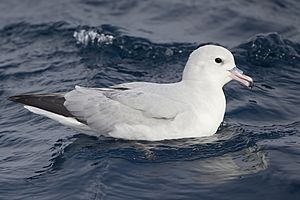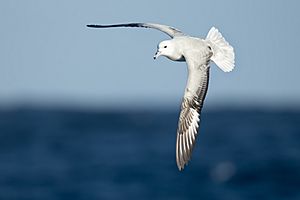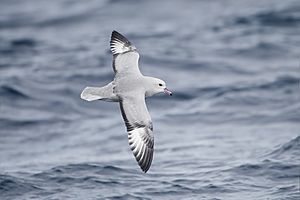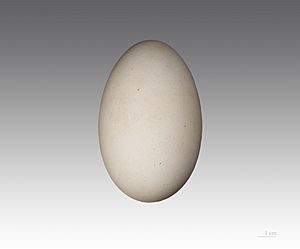Southern fulmar facts for kids
Quick facts for kids Southern fulmar |
|
|---|---|
 |
|
| Conservation status | |
| Scientific classification | |
| Genus: |
Fulmarus
|
| Species: |
glacialoides
|
The southern fulmar (Fulmarus glacialoides) is a type of seabird that lives in the Southern Hemisphere. It's often called the Antarctic fulmar or silver-grey fulmar. This bird is related to the northern fulmar. Both belong to a group of birds called fulmars, which are part of the petrel family.
Southern fulmars are mostly light grey on top and white underneath. They have a special white patch on their wings. These birds make their homes along the coast of Antarctica and on nearby islands. In winter, they fly north to warmer areas. They build their nests in large groups on cliffs, laying just one egg on a rocky ledge or in a crack. Their diet includes small ocean creatures like krill, fish, and squid. They usually pick their food right from the water's surface.
Contents
What Does a Southern Fulmar Look Like?
The southern fulmar is a fairly large and strong petrel. It grows to be about 45 to 50 centimeters (18 to 20 inches) long. Its wings can spread wide, from 110 to 120 centimeters (43 to 47 inches). Male birds usually weigh around 795 grams (28 ounces). Females are a bit smaller, weighing about 740 grams (26 ounces). When they are sitting on their eggs, their weight increases. Males can reach 1005 grams (35 ounces), and females 932 grams (33 ounces).
This bird flies by flapping its wings a little and then gliding for long distances. It often looks down to search the water below. Its wings are quite wide and rounded, and it holds them stiffly while flying. The bird's feathers are mostly light silvery-grey on its back and white on its belly. Its head is white with a light grey top. The tips of its wings are dark, almost black, with a big white spot. The back edge of its wings is also dark. Its legs and feet are a pale blue color. The bill is pink with a black tip. It also has dark bluish parts around its nostrils. Young birds have a thinner bill than adult birds.
Southern fulmars are usually quiet. But when they are at their nest or feeding in groups, they make loud, cackling sounds. When a pair of birds is trying to attract each other, they make soft humming and deep croaking noises.
How Southern Fulmars Are Classified
The southern fulmar was first described in 1840. A Scottish scientist named Andrew Smith studied a bird he found near the Cape of Good Hope. He gave it the scientific name Procellaria glacialoides. Later, scientists moved it to the Fulmarus group. Its closest relative is the northern fulmar, F. glacialis. Scientists have studied their genes to learn more. This research suggests that these two types of fulmars became separate species a very long time ago, during the Pleistocene ice age.
Where Southern Fulmars Live
Southern fulmars have large groups, called colonies, on many islands around Antarctica. These islands include the South Sandwich Islands, South Orkney Islands, South Shetland Islands, Bouvet Island, and Peter I Island. They also breed in several places along the coast of Antarctica itself.
When they are out at sea, southern fulmars mostly stay near the edge of the floating pack ice during summer. The water in these areas is very cold, usually between -1.5 to 0.5 degrees Celsius (29.3 to 32.9 degrees Fahrenheit). In winter, they travel further north, sometimes reaching as far as 40 degrees South latitude. They can be found even further north in the cool waters of the Humboldt Current, reaching the coast of Peru. A small number of these birds are seen off the coasts of South Africa, southern Australia, and New Zealand. After big storms, many birds can sometimes be found washed up on beaches. There have been a few unconfirmed sightings off the west coast of North America.
This is a common bird species. There are at least 4 million southern fulmars in the world. About 1 million pairs breed just on the South Sandwich Islands. Experts believe this species is not in danger of disappearing. Because of this, Birdlife International lists it as a species of least concern.
Southern Fulmar Behavior
Reproduction and Life Cycle
Southern fulmar breeding colonies can have hundreds of birds. They arrive at their nesting cliffs in October, choosing ice-free areas. During courtship, a pair will sit together, calling, waving their heads, and gently pecking or cleaning each other's feathers. Their nest is a shallow dip in the ground, lined with small stones. They build it in a spot protected from the wind, often on a ledge, a rocky slope, or in a crack.
A single white egg is laid in late November or early December. The egg is about 76 by 51 millimeters (3 by 2 inches) and weighs around 103 grams (3.6 ounces). Both parents take turns sitting on the egg to keep it warm. This incubation period lasts about 45 days, with each parent taking shifts of 3 to 9 days.
When young birds first hatch, their soft down feathers are white. They have a bluish-grey color on their back. The second set of down feathers is grey on their upper body and sides. The rest of their belly and forehead stay white. The young birds are ready to fly, or fledge, after about 52 days. Bad weather can cause many eggs and chicks to die. Predators like skuas and sheathbills also hunt them. As the parents get older, they become better at raising their young. For example, 6 to 8-year-old parents successfully raise about 48% of their chicks. But 18 to 20-year-old parents can raise up to 87% of their chicks.
How Southern Fulmars Find Food
Southern fulmars often gather in large groups, sometimes with other seabirds. This happens when there is a lot of food in one place, like a big group of krill. They also gather around whaling ships and fishing boats. Krill and other small crustaceans are the most important part of their diet. But they also eat small fish, such as the Antarctic silverfish, and squid like Psychroteuthis, Gonatus, and Galiteuthis. They usually pick their food from the surface of the water. However, they will sometimes dive underwater to catch food.
See also
 In Spanish: Fulmar austral para niños
In Spanish: Fulmar austral para niños





